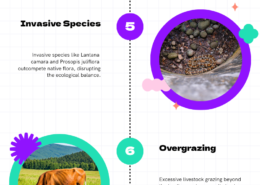Roadmap for Answer Writing 1. Introduction Begin by introducing the concept of mangroves as a unique and vital ecosystem, emphasizing their importance to both terrestrial and marine life. Mention their geographic distribution in India and how they form part of the coastal and ...
India’s natural vegetation is incredibly diverse, but it faces several significant threats. Here are the major threats to vegetation in India, which you can use to create an infographic: 1. Deforestation Causes: Logging, agriculture, urbanization, and infrastructure development. Impact: Loss of habiRead more
India’s natural vegetation is incredibly diverse, but it faces several significant threats. Here are the major threats to vegetation in India, which you can use to create an infographic:
1. Deforestation
- Causes: Logging, agriculture, urbanization, and infrastructure development.
- Impact: Loss of habitat, reduction in biodiversity, and disruption of ecosystems.
2. Urbanization
- Causes: Expansion of cities and towns.
- Impact: Conversion of natural landscapes into urban areas, leading to habitat fragmentation and loss.
3. Pollution
- Causes: Industrial activities, vehicular emissions, and agricultural runoff.
- Impact: Soil degradation, water contamination, and adverse effects on plant health.
4. Climate Change
- Causes: Global warming, changes in precipitation patterns, and extreme weather events.
- Impact: Altered growth patterns, increased vulnerability to pests and diseases, and shifts in vegetation zones.
5. Invasive Species
- Examples: Lantana camara, Chromolaena odorata, and Prosopis juliflora.
- Impact: Competition with native species, alteration of habitats, and disruption of ecological balance.
6. Overgrazing
- Causes: Livestock grazing beyond the carrying capacity of the land.
- Impact: Soil erosion, loss of plant cover, and degradation of grasslands.
7. Mining
- Causes: Extraction of minerals and resources.
- Impact: Destruction of vegetation, soil erosion, and pollution of water bodies.
8. Overexploitation
- Causes: Unsustainable harvesting of timber, medicinal plants, and other forest products.
- Impact: Depletion of resources and loss of biodiversity.
9. Habitat Destruction
- Causes: Infrastructure projects, agriculture, and human settlements.
- Impact: Loss of natural habitats, fragmentation, and decline in wildlife populations.
10. Decline of Pollinators
- Causes: Pesticide use, habitat loss, and climate change.
- Impact: Reduced pollination, affecting plant reproduction and crop yields.
These threats collectively pose a significant challenge to the conservation of India’s natural vegetation. Addressing these issues requires coordinated efforts in conservation, sustainable practices, and policy implementation.
See less

Model Answer Introduction The mangroves of India are vital ecosystems that serve as a sanctuary for a diverse range of species, offering critical resources and protection to both terrestrial and marine life. These coastal forests, found predominantly along India’s coastline and in river estuaries, aRead more
Model Answer
Introduction
The mangroves of India are vital ecosystems that serve as a sanctuary for a diverse range of species, offering critical resources and protection to both terrestrial and marine life. These coastal forests, found predominantly along India’s coastline and in river estuaries, are crucial for biodiversity and environmental health.
Geographic Distribution and Species Diversity
India’s mangroves are concentrated in three major areas: the Sundarbans (West Bengal and Bangladesh), the Andaman and Nicobar Islands, and the Gulf of Kutch (Gujarat). Smaller patches exist along the country’s extensive coastline. These mangroves host around 80 species of plants, including iconic species like the Sundari tree (Heritiera fomes) in the Sundarbans and species like Avicennia, Rhizophora, and Ceriops, contributing to their rich biodiversity.
Ecological Role and Protection
Sustainable Livelihoods
The mangrove ecosystems support coastal communities by providing resources for fishing, aquaculture, lumber, and ecotourism, ensuring economic sustainability while conserving biodiversity.
Conclusion
Mangroves in India are essential to maintaining ecological balance and supporting biodiversity. Protecting these ecosystems through international conventions and local conservation efforts ensures their survival and the well-being of the communities that depend on them.
See less